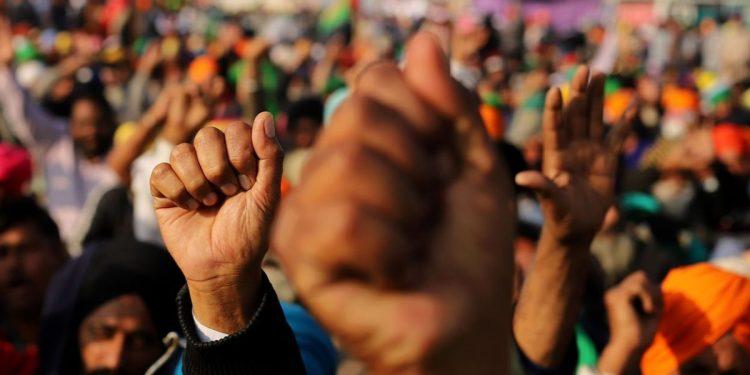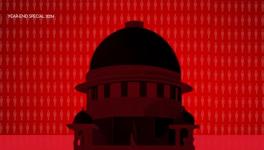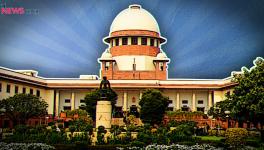Curbing Protests on “Sub Judice” Ground is Contrary to Legislative Intent of the Constituent Assembly and the Constitution

In light of the Supreme Court’s recent order on examining whether the right to protest is an absolute right and a party already invoking a legal remedy before a court of law could still protest against a matter which is sub-judice, S.N. SAHU examines the Constituent Assembly Debates in this context.
———–
A two-judge division bench of the Supreme Court consisting of Justices A.M. Khanwilkar and C.T. Ravikumar, while hearing a writ petition filed by the Kisan Mahapanchayat challenging denial of permission by the Delhi Police to stage a satyagraha at the Jantar Mantar, and praying for permission to do so, observed in their order,
“(w)e deem it appropriate to examine the central issue as to whether the right to protest is an absolute right and, more so, the writ petitioner having already invoked the legal remedy before the Constitutional Court by filing writ petition, can be permitted to urge much less assert that they can still resort to protest in respect of the same subject matter which is already sub-judice before the Court.”
While hearing the matter, Justice Khanwilkar had remarked “… how can there be protests when the matter is sub judice here? Why are there protests when the laws have been kept in abeyance?” He later said that “[t]here is no point in continuing to protest once you have come to the court”.
These order and remarks by the Supreme Court clearly frame a binary between the fundamental right to protest and the right to seek judicial remedy as something which should be seen as one opposed to the other. Such an understanding puts these two rights as mutually exclusive, and is contrary to the legislative intent of the Constituent Assembly where Article 19, which was Article 13 of the draft Constitution, was discussed at length, attained finality and became part of the Constitution.
Besides, such an understanding that a citizen preferring to seek judicial remedy on an issue loses the right to express their grievances related to the matter through protests is contrary to some judgments of the Supreme Court delivered by three judges, larger in strength than the Division Bench which gave the aforementioned order.
Also Read: “Sub judice” not a ground to curtail the right to protest a parliamentary law
Legislative intent of the Constituent Assembly
It would be instructive to peep into the Constituent Assembly Debates to understand the legislative intent of the framers of the Constitution on the right to protest. As is mentioned earlier, Article 19 of the Constitution was Article 13 of the draft Constitution. In the Constituent Assembly, the said Article was discussed on December 1st & 2nd, 1948 and then again on October 16th & 17th, 1949.
During the discussion, several Members of the Assembly hailed the Article for its extraordinary significance in guaranteeing the freedom of people after a long struggle and enormous sacrifice. Prof. Shibban Lal Saxena said in the Constituent Assembly on December 2, 1948 that “… this article may be truly stated to be the charter of our liberties and this is probably the most important article in the whole Draft Constitution.”
Kazi Syed Karimuddin, while addressing the then-Vice President, stated that “…there is no denying the fact that this article is the very life of the Draft Constitution.”
He invoked the words of the Chairman of the Drafting Committee, Dr B.R. Ambedkar, who, in his book ‘States and Minorities’ wrote that “[n]o law shall be made abridging the freedom of the press, of association and of assembly except for consideration of public order and morality.”
A perusal of the debates of the Constituent Assembly on Article 19 (Article 13 of the draft Constitution) clearly educates us that nowhere did any Member ever state that citizens who knock the doors of the court seeking judicial remedy on a matter should be barred from protesting on the same matter in a peaceful manner.
Only on one occasion, the sub judice issue cropped up – when on October 17, 1949, T.T. Krishnamachari moved an amendment to include “contempt of court” in the category of reasonable restrictions under sub-clause (2) to the Article, and said that:
“The idea, at any rate, of a part of that amendment was to cover one category of what might be called lapses in the exercise of freedom of speech and expression, namely, a person might be speaking on a matter which is sub judice and thereby interfere with the administration of justice.”
He further clarified the intent by saying that, in the said amendment,
“…contempt of court will figure on a par with libels, slander, defamation or any matter which offends against decency or morality, or which undermines the security of, or tends to overthrow, the State. Actually, contempt of court will figure with the first three and it is a very necessary protection so far as our law courts are concerned…”
Krishnamachari’s amendment was accepted by the Chairman, Dr. Ambedkar, which is why “contempt of court” now forms part of the reasonable restrictions to the freedom of speech guaranteed to the citizens who, empowered by that freedom, also exercise the fundamental right to protest.
Also Read: Contempt, dignity and fair criticism: What do they mean to courts?
The material point here is that the citizens, while engaging in protest, should exercise their right to freedom of speech and expression and assembly in a manner which should not amount to contempt to court. By protesting against a legislation which is being examined by the courts, no contempt of court can be said to be committed, as the protest is against a matter which is the outcome of the actions of the executive or the legislature and not of the judiciary.
Here, it has to be kept in mind that the ground of sub judice does not, in itself, form part of the reasonable restrictions under Article 19.
Supreme Court previously (and quite recently) upheld protests in sub judice matters
The Supreme Court, in its judgment in the case of Anuradha Bhasin vs. Union of India (2020), observed that “[t]he nature of fundamental rights under Part III of the Constitution is well settled. The fundamental rights are prescribed as a negative list, so that “no person could be denied such right until the Constitution itself prescribes such limitations”.”
It is, therefore, clear that in the absence of an express provision of “sub judice” as part of the reasonable restrictions laid down under Article 19, it may not be judicious to say that citizens cannot protest on matters which are being considered by the courts of law.
Besides, when country-wide protests were being held against the Citizenship (Amendment) Act, 2019 (CAA), multiple petitions challenging the constitutional validity of the CAA were pending before the Supreme Court. In fact, in the case of Amit Sahni vs. the Commissioner of Police & Ors. (2020), a three-judge bench of the Supreme Court, dealing with the Shaheen Bagh protests against the CAA, observed:
“There have been protests against this legislation in Delhi and in different parts of the country. We had noted in our order dated 17.02.2020 that despite the law facing a constitutional challenge before this Court, that by itself will not take away the right to protest of the persons who feel aggrieved by the legislation.”
Also Read: Why civil protests must necessarily disrupt the status quo
The former Chief Justice of India, S.A. Bobde, while dealing with a public interest litigation (PIL) praying for the removal of farmers protesting against the three farm laws, made it amply clear that “…. this Court will not interfere with the protest in question” in spite of the Supreme Court allowing petitions challenging the constitutional validity of the three farm laws.
On January 12, 2021, a three-judge bench of the Supreme Court headed by then CJI Bobde, while staying the implementation of the three farm laws and setting up a committee of experts to discuss with the farmers and other stakeholders, observed:
“We are looking to solve the problem. If you want to agitate indefinitely, you can. Every person who is genuinely interested in solving the problem is expected to go before the Committee. The Committee will not punish you or pass any orders. It will submit a report to us. We are going to take the opinion of the organizations.”
It is instructive to note that Chief Justice Bobde had also clarified that “[w]e are concerned about only the validity of the laws and also about protecting the life and property of citizens affected by protests. We are trying to solve the problem in accordance with the powers we have”.
The validity of any law is examined from legal and constitutional perspectives, by a court of law. Legislation, laws and measures of the executive have multiple perspectives beyond law and jurisprudence. While courts of law examine the legal and constitutional perspectives, they often do not have the power to deal with other perspectives, such as the policy rationale or desirability of the law, which are equally important, if not more.
The farmers’ protests, or for that matter, several other protests are not just focused on legal issues; there are also economic, social, cultural and even moral issues involved. The protests articulate such issues and, therefore, it would not be prudent to say that there should be no protests on issues if the matter is sub judice.
Gandhi and Ambedkar on the legitimacy of protests
Mahatma Gandhi once famously said that, “Demands of equity supersede the letter of the law”, and on October 29, 1944, while talking to the peasant leader, N.G. Ranga, Gandhi had presciently said that “[i]f the legislature proves itself to be incapable of safeguarding kisans’ interests, they will of course always have the sovereign remedy of civil disobedience and non-cooperation.”
He also gave civil disobedience an appropriate place in post-independence India by saying that it “…can never be directed for a general cause such as for Independence. The issue must be definite and capable of being clearly understood and within the power of the opponent to yield.”
Dr Ambedkar was the one who coined the slogan “Educate, Agitate and Organise”, which is invoked by professor Amartya Sen as a method for public reasoning for deepening democracy and ensuring justice to people.
Protests and agitation remained central to our freedom struggle and are now a fundamental right enshrined in the Constitution of India. To curb it on the ground that in case of sub judice matters, protests cannot be organised, would be an offence to the ethos of the freedom struggle, the vision of Gandhi and Ambedkar, and the constitutional morality which citizens of India and all institutions of governance, including the judiciary, are duty bound to uphold.
(S.N. Sahu was Officer on Special Duty and Press Secretary to President of India K.R. Narayanan. The views expressed are personal.)
Get the latest reports & analysis with people's perspective on Protests, movements & deep analytical videos, discussions of the current affairs in your Telegram app. Subscribe to NewsClick's Telegram channel & get Real-Time updates on stories, as they get published on our website.
























